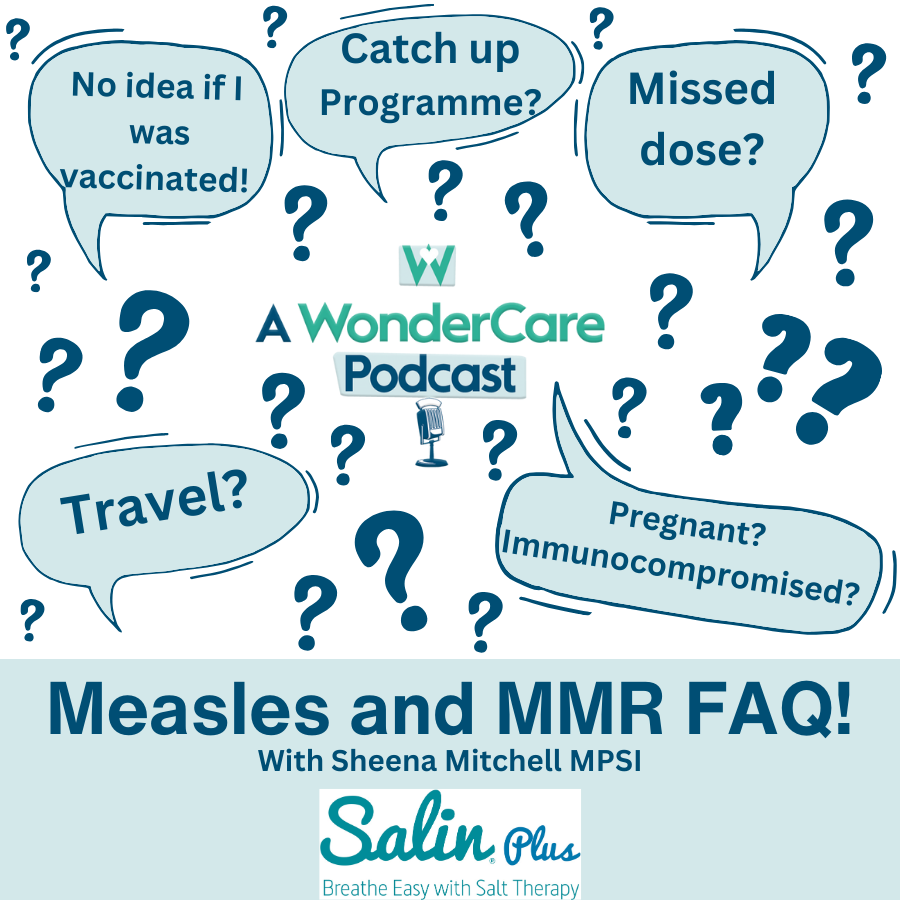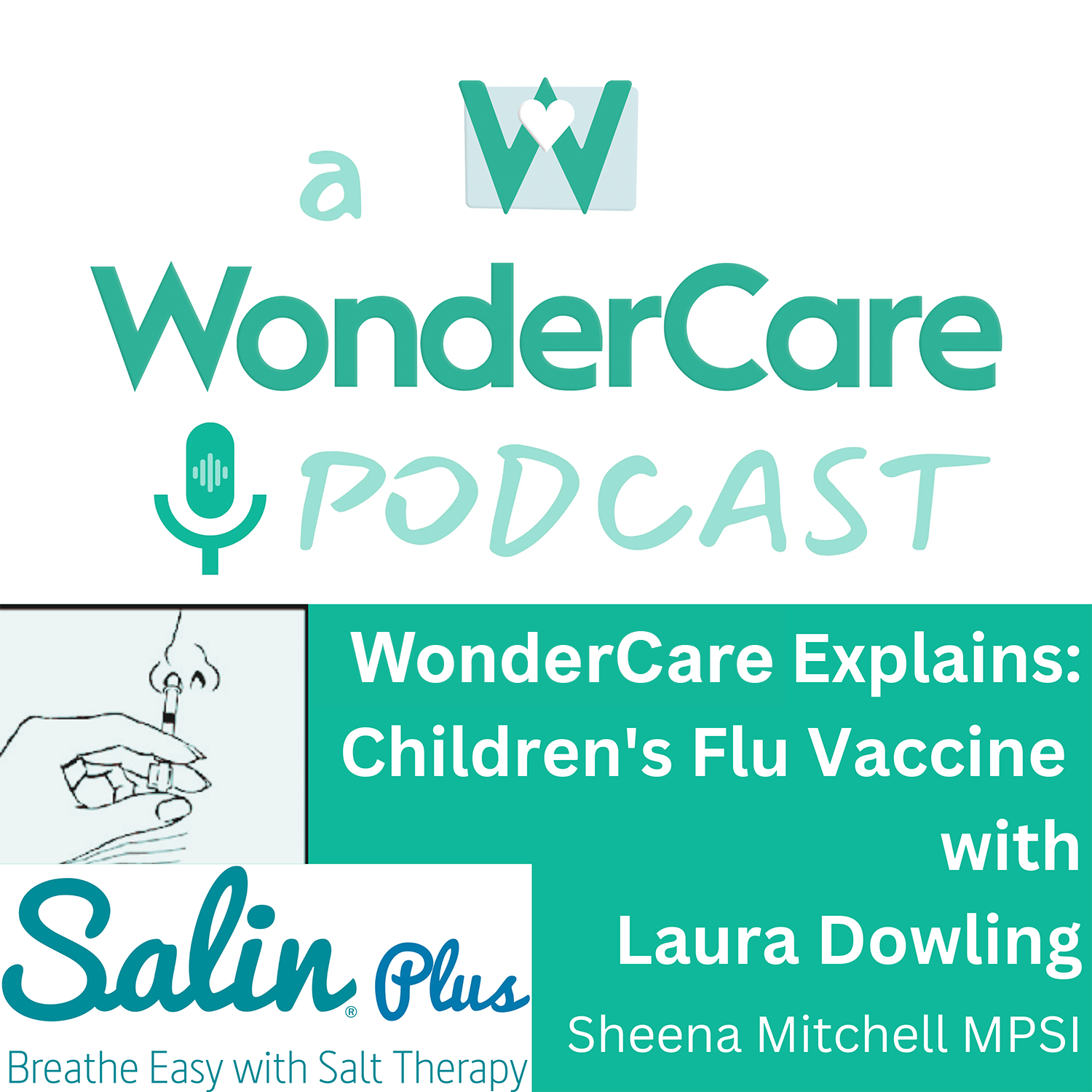Episode Transcript
Speaker 1 00:00:04 Hello and welcome to a Wonder Care podcast, formally known as Wonder Baba podcast. I'm Sheena Mitchell, pharmacist and mom of three. I combine healthcare and practical advice to support you on your parenting journey. I bring you this episode with the support of Salon Plus Breathe ECE therapy device. Today I'm gonna be talking all about impetigo. So Impetigo is a very, very, very contagious bacterial skin condition. It mostly affects children right up to about 14 years of age. With it being more common in kids under four, it's not as common in adults, and this is really probably due to the nature of close contact that kids have in CREs and school environments. There's also an element of hand hygiene there. Cause within Infantigo you get blisters and scabbing and weeping from a red rash, and the fluid within the blisters is contagious. So you know, maybe children aren't as diligent about the hand washing and they share a lot more toys and stuff.
Speaker 1 00:01:09 So that really does help to encourage the spread of infection. Inigo causes sores and blisters on the skin. There's actually two types of inigo. No one ever knows. This one form is called bulls, and the other form, which is actually more contagious, is known as non bulls. So bulls, inigo causes blisters and rash which form all over. So on the face, the chest, the back, the arms and the legs and the blisters are filled with fluid and they spread quickly around the body. They can take several days to burst. So this is one of the key differences between bolus and non bolus inigo. When the blisters burst, they leave a yellow crust on the skin. These blisters can be itchy, but they're not normally too painful. With bolus inigo, it's more generalized, so you can get a high fever, swollen glands and diarrhea. Non bullous inigo is actually the more common kind, so it accounts for approximately 70% of all cases.
Speaker 1 00:02:16 This is because it is more highly contagious. This is the one that I suppose we see more often in the pharmacy. It affects the skin around the mouth and nose, but can occur on the limbs as well, and often it'll be on the hands as well as around the mouth and nose. It starts again with little small g blisters and spreads, but as I mentioned there, it doesn't become too widespread. Unlike the other form of emgo, the blisters do tend to burst fairly quickly, and again, they form that yellowy golden crust on the skin. If Impetigo starts on healthy skin, it's known as primary em pettigo. If it starts on damaged skin, say from a wound, or if you've got someone who has eczema, that's called secondary infantigo. The most common blame for infantigo is streptococcus ioes and staphyloccus orus. So these are two types of bacteria. Before I go on to talk about the treatment of Inigo, I'd want to discuss a few tips for management and treatment at home.
Speaker 1 00:03:27 I just want to take a little break for a second to say that I'm delighted to partner again with one of my all-time favorite products. Salon Plus, this is the world's first a hundred percent natural dry soil therapy device. It's clinically proven to relieve a wide range of allergens and respiratory conditions. The soil therapy method has been trusted for generations and is now hugely popular worldwide. As more and more people recognize the superb results achieved from a natural and non-invasive method, this device will help you breathe these easier and sleep better. Infantigo will go away untreated usually within a couple of weeks, but because it's so contagious, I do definitely recommend a GP visit, especially if there's other kids in the house. Try and discourage your child from scratching. Not the easiest task, but if it's a young child, you could maybe use scratch mittens on little babies and with all other children, just do try to keep their nails short so they're not able to do damage of scratching themselves.
Speaker 1 00:04:30 I'd also make sure at night that they're in full length pajamas, and this stops them from irritating the skin during their sleep. Unfortunately, appetites a bit of a labor intensive infection. <laugh>, everything needs to be cleaned just as much as you can. It's not an easy task when you have little people around, but do make sure that everyone is washing their hands with antibacterial soap. Make sure that nobody is sharing towels and the person who's infected should use a clean towel each time they wash. So I would say maybe stock up on a little bit of extra detergent because the washing machine will be on frequently. Try and wash the towels and bed sheets of people who are infected, uh, separately. So in a hot wash, if you can, it's definitely a good idea to try and wipe down toys between plays and just try and get kids not to share toys if at all possible.
Speaker 1 00:05:29 A handy hack that I used to use in any of these kind of scenarios is that you need to get them involved. So get a towel down on your floor so that it doesn't get destroyed, and put a couple of basins of water on the floor and let the kids wash. I'm doing inverted com signs here, their toys with a little sponge and some soap. I mean, this is toddler heaven. They get kind of messy play and they're washing their hands and their toys. So it's kind of win-win for everyone other than maybe the ti. Afterwards, be very careful to ensure that the people with Empa igo aren't sharing food that they've handled, and this is because the bacteria that's inigo can actually cause food poisoning. So you don't want to add insult to injury. How we treat inigo. Impetigo is treated using antibiotics. As I said, it is highly contagious, so it can be useful to be proactive in visiting your GP if you have Inigo in the house.
Speaker 1 00:06:37 The guidelines are that a topical antibiotic, which basically means fucidin can be used, but only if there are three lesions or less. Because we have resistance developing to antibiotics, we really are trying to reserve the use of topical. So cream antibiotics for just very localized infections. If they have more than three lesions, the advice would be to use oral antibiotics. So again, you're gonna see your gp, and generally these antibiotics are used for five to seven days. If your GP initially prescribed a cream and the rash isn't improving or it's becoming more widespread, I'd urge you to get back in touch with them. And if your child's blisters are very small, kind of pu built little ulcers and they develop a very dark brown crust, this can sometimes be in ulcerated form of impetigo and because it's deep picking and cause scarring. So it is important to get that checked with the doctor as well.
Speaker 1 00:07:42 Do you keep an eye that your child is feeling well and is going to the toilet as normal? Keep an eye out for any nausea, headaches, or body swelling because sometimes the bacteria can start to affect a child negatively, and it's important that that's picked up on when can your child go back to school. It's important to contact your own child's school or childcare facilities to see what their particular guidance is. But as a rule at home, you need to keep your child home until the lesion have crusted over 24 hours after starting an antibiotic, your childcare facility or school may be happy enough for you to let your child back, but if the lesions aren't healed, then they should be covered with a little bit of gauze and tape just until they're fully better. Okay, that is your very quick guide to another infectious disease, inigo, and for a change it's caused by bacteria and not a virus.
Speaker 1 00:08:37 I really hope that you have found the information in this podcast episode helpful. If you did, I'd really love if you could give us a little review on Spotify or Apple Podcasts or wherever you get your podcasts. That helps me to get more free accessible healthcare information out to parents because the streaming platforms start to show my podcast more. I really, really appreciate everyone listening and joining in and helping and sending in questions so that I know what you want to learn about. And I'll be here soon with another infectious disease for us to tackle. Don't forget to keep an eye on my Instagram page at Wonder Care underscore i r l. You can pop any questions you have into the question boxes when they open so that I can address your question during a podcast. Thanks for listening.


